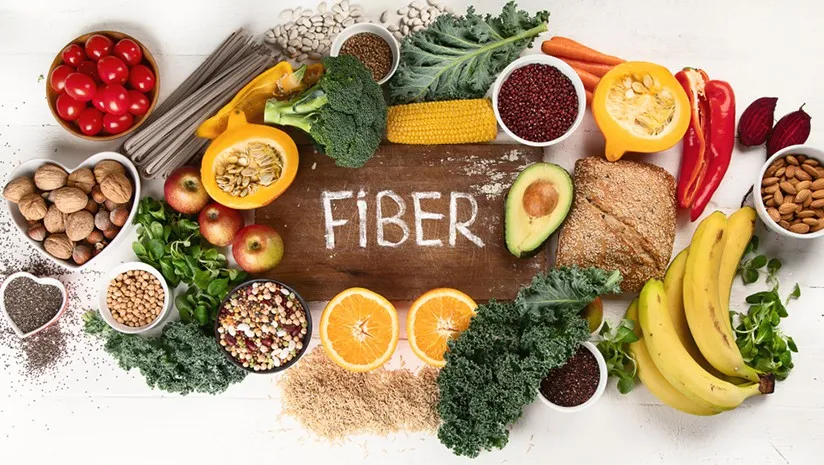Hello and welcome to the Stepwise Enhanced Blog Post Series. In this series we will explore a number of nutrition topics with the simple goal of providing you with more information. This series is meant to be an educational supplement to your current Enara program as we will dive deeper into topics than a traditional appointment window may allow. The sixth installment of this series will cover dietary fiber in all its glory.
Most people know that fiber is good. It’s not a secret nor is it controversial. Given my confidence in this, I’m surprised that public health professionals are concerned about the population’s fiber intake. It turns out they are concerned for good reason. Fiber has been identified as a “nutrient of concern” in the Dietary Guidelines for Americans since 2005 (1). This designation means the amount the public eats is problematic. People don’t get enough and they haven’t been for a while. This is certainly not ideal as fiber is very health promoting. Let’s discuss why.
The Benefits of Dietary Fiber
Fiber has many benefits. One is that it can help to support weight loss and weight management. This is as it slows digestion, helping to maintain levels of fullness. It can also help to reduce cholesterol levels as well as lower the risk for cardiovascular disease. Further, fiber can help to reduce blood sugar levels, which helps to prevent diabetes. Of course, as is probably its most famous of benefits, it helps with bowel and digestive health as well (2).
Now that we have detailed why fiber is so good, let’s talk about the two main types: insoluble fiber and soluble fiber.
Types of Fiber
Insoluble fiber does not dissolve in water. It adds bulk to stool and moves through the digestive tract more quickly than soluble fiber. You can almost think of it like a pipe cleaner in terms of its functionality. It helps to prevent constipation (2), cleaning the pipes. Insoluble fiber may help to prevent diverticulitis as well as colon cancer. (3) Examples of insoluble fiber include: wheat bran, root vegetables (carrots, beets, radish), fruit skins, and intact whole grains.
Soluble fiber has a different effect on digestion. It slows everything down as it attracts water and forms a gel-like substance as it’s digested. This type of fiber, as it slows digestion, helps to keep you fuller for longer. (3) It can also function to lower cholesterol and blood sugar levels. (2) Examples of soluble fiber include: oats, beans, nuts, flax and other seeds, peas, apples and oranges.
Like I mentioned at the top, fiber intake levels among the U.S. population are problematic. According to “Communication Strategies From a Food and Fiber Summit,” the “vast majority of Americans fall exceedingly short of meeting [fiber] recommendations.” (1) The paper reports that there are a few reasons for this. One is that people are confused about what constitutes a good source of fiber. (1) Another problem is that people aren’t sure how much fiber they need. How much and from where are simple enough. Let’s tackle these two sources of confusion.
Dietary Fiber Recommendations
So how much should you get?
| Women | Grams Per Day (g/d) |
| Aged 19-50 | 25g/d |
| Aged 50+ | 21g/d |
| Men | Grams Per Day (g/d) |
| Aged 19-50 | 38g/d |
| Aged 50+ | 30g/d |
The table above lists the official recommendations from the Institute of Medicine (1). Another recommendation comes from the USDA and it is perhaps more digestible in terms of volume. They recommend consuming about 14g of fiber per 1000 calories consumed (4). This breakdown may help to make getting enough a bit more attainable breaking it into segments. Whichever way of thinking about it that works for you is encouraged. The NIH reports most Americans get only about 16g each day which is not enough. (2)
Now we have covered why fiber is so good and how much you should get each day, let’s discuss where you can get it.
| Fiber-rich foods | Grams per serving size |
| boiled split peas and lentils; black, lima, and baked beans | 10-15 g per cup |
| green peas, boiled | 8.8 g per cup |
| raspberries | 8 g per cup |
| cooked whole wheat spaghetti | 6.3 g per cup |
| cooked pearled barley | 6 g per cup |
| medium pear with skin | 5.5 g per pear |
| medium oat bran muffin | 5.2 g per muffin |
| medium apple with skin | 4.4 g per apple |
| bran flakes | 5.5 g per 3/4 cup |
| cooked instant oatmeal | 4 g per cup |
| brown rice | 3.5 g per cup |
| boiled Brussels sprouts | 4.1 g per cup |
| almonds | 3 g per 1 oz (23 almonds) |
| chia seeds | 10.6 g per 1 oz (2 tbsp) |
Per the FDA, a good source of dietary fiber is one with at least 3g per serving. An excellent source has at least 5g per serving. (1) There are a few helpful things to keep in mind when aiming to increase your fiber intake. First of all, it’s important to remember that the more refined or processed a food typically is, the lower its fiber content will be (5). A perfect example of this is an apple. A medium apple has about 4.4g of fiber which is a good serving. ½ cup of applesauce on the other hand has only 1.4g, significantly less than the whole apple. Taking it another step further, ½ cup of apple juice has no fiber at all (5). The whole intact apple has significantly more fiber.
Another helpful tip here is not a new concept but it remains an important one: read the ingredient list and nutrition label. There are many phrases out there on packaging that would imply that the product has good fiber content, such as “multigrain” or “12 grain.” The fiber content may not be comparable to a whole grain though. In reality, those proclamations on packaging are nothing more than a marketing ploy. To ensure you are truly getting a good source, look for “whole” on the ingredient list as the first ingredient and of course check the fiber content. A helpful rule of thumb is to choose products with at least 1g of fiber per every 10g of carbohydrates. (6) Choosing complex carbohydrates over refined is another great way to increase your fiber intake as well. For example, choosing brown rice instead of white rice and/ or whole wheat pasta instead of white pasta would substantially boost your fiber intake.
Here are some other ways that may be helpful to increase your fiber intake.
- Add nuts, seeds, and/or fruit to your breakfast
- Topp salads with seeds for a fiber boost as well as a crunch component
- Try choosing vegetables as a snack; they pair nicely with a healthful dip such as salsa or hummus
- Add beans to your meals
- Eat more whole, natural foods and fewer processed foods
Too Much Fiber?
Fiber can do great things for the body but it is possible to have too much. Too much can cause gastrointestinal discomfort which can manifest itself in many ways. As you are striving to increase your fiber intake, do so slowly. Work more in gradually so your gastrointestinal system has time to adapt. Listen to your body as well. It’s also very important to increase your water intake as you increase fiber intake. Another important note is that some people may not tolerate fiber as well as others. If that is the case you should of course listen to your body and do what makes you feel best.
Conclusion
Fiber has many benefits and unfortunately most people don’t get enough. When aiming to increase intake, remember to start slowly and listen to your body. Also be sure to drink plenty of water. Fiber has many benefits, make sure you are getting enough!
References
- Quagliani D, Felt-Gunderson P. Closing America’s Fiber Intake Gap; AM J Lifestyle Med. 2017; 11(1): 80-85; https://www.ncbi.nlm.nih.gov/pmc/articles/PMC6124841/#bibr9-1559827615588079; Accessed December 9, 2021.
- Smiley B. How Much Fiber Should I Eat Per Day?; Healthline; https://www.healthline.com/health/food-nutrition/how-much-fiber-per-day; Updated October 12, 2017; Accessed December 9. 2021.
- Cafasso J; Can You Actually Ingest Too Much Fiber?; Healthline; https://www.healthline.com/health/food-nutrition/too-much-fiber; Update April 16, 2019; Accessed December 9, 2021.
- Ask USDA; USDA; https://ask.usda.gov/s/article/How-much-dietary-fiber-should-I-eat; Published July 17, 2019; Accessed December 9, 2021.
- Larson H; Easy Ways to Boost Fiber in Your Daily Diet; https://www.eatright.org/food/vitamins-and-supplements/types-of-vitamins-and-nutrients/easy-ways-to-boost-fiber-in-your-daily-diet; Published March 1, 2021; Accessed December 9, 2021
- McManus K; Should I be eating more fiber?; Harvard Health Blog; https://www.health.harvard.edu/blog/should-i-be-eating-more-fiber-2019022115927; Published February 27, 2019; Accessed December 9, 2021.



